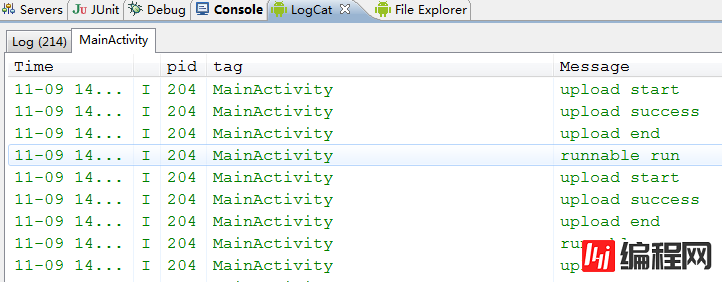本实例实现每隔5秒上传一次,通过服务器端获取手机上传过来的文件信息并做相应处理;采用Android+Struts2技术。 一、Android端实现文件上传 1)、新建一个An
本实例实现每隔5秒上传一次,通过服务器端获取手机上传过来的文件信息并做相应处理;采用Android+Struts2技术。
一、Android端实现文件上传
1)、新建一个Android项目命名为androidUpload,目录结构如下:

2)、新建FORMFile类,用来封装文件信息
package com.ljq.utils;
import java.io.File;
import java.io.FileInputStream;
import java.io.FileNotFoundException;
import java.io.InputStream;
public class FormFile {
private byte[] data;
private InputStream inStream;
private File file;
private String filname;
private String parameterName;
private String contentType = "application/octet-stream";
public FormFile(String filname, byte[] data, String parameterName, String contentType) {
this.data = data;
this.filname = filname;
this.parameterName = parameterName;
if(contentType!=null) this.contentType = contentType;
}
public FormFile(String filname, File file, String parameterName, String contentType) {
this.filname = filname;
this.parameterName = parameterName;
this.file = file;
try {
this.inStream = new FileInputStream(file);
} catch (FileNotFoundException e) {
e.printStackTrace();
}
if(contentType!=null) this.contentType = contentType;
}
public File getFile() {
return file;
}
public InputStream getInStream() {
return inStream;
}
public byte[] getData() {
return data;
}
public String getFilname() {
return filname;
}
public void setFilname(String filname) {
this.filname = filname;
}
public String getParameterName() {
return parameterName;
}
public void setParameterName(String parameterName) {
this.parameterName = parameterName;
}
public String getContentType() {
return contentType;
}
public void setContentType(String contentType) {
this.contentType = contentType;
}
}
3)、新建SocketHttpRequester类,封装上传文件到服务器代码
package com.ljq.utils;
import java.io.BufferedReader;
import java.io.InputStreamReader;
import java.io.OutputStream;
import java.net.InetAddress;
import java.net.Socket;
import java.net.URL;
import java.util.Map;
public class SocketHttpRequester {
public static boolean post(String path, Map<String, String> params, FormFile[] files) throws Exception{
final String BOUNDARY = "---------------------------7da2137580612"; //数据分隔线
final String endline = "--" + BOUNDARY + "--\r\n";//数据结束标志
int fileDataLength = 0;
for(FormFile uploadFile : files){//得到文件类型数据的总长度
StringBuilder fileExplain = new StringBuilder();
fileExplain.append("--");
fileExplain.append(BOUNDARY);
fileExplain.append("\r\n");
fileExplain.append("Content-Disposition: form-data;name=\""+ uploadFile.getParameterName()+"\";filename=\""+ uploadFile.getFilname() + "\"\r\n");
fileExplain.append("Content-Type: "+ uploadFile.getContentType()+"\r\n\r\n");
fileExplain.append("\r\n");
fileDataLength += fileExplain.length();
if(uploadFile.getInStream()!=null){
fileDataLength += uploadFile.getFile().length();
}else{
fileDataLength += uploadFile.getData().length;
}
}
StringBuilder textEntity = new StringBuilder();
for (Map.Entry<String, String> entry : params.entrySet()) {//构造文本类型参数的实体数据
textEntity.append("--");
textEntity.append(BOUNDARY);
textEntity.append("\r\n");
textEntity.append("Content-Disposition: form-data; name=\""+ entry.geTKEy() + "\"\r\n\r\n");
textEntity.append(entry.getValue());
textEntity.append("\r\n");
}
//计算传输给服务器的实体数据总长度
int dataLength = textEntity.toString().getBytes().length + fileDataLength + endline.getBytes().length;
URL url = new URL(path);
int port = url.getPort()==-1 ? 80 : url.getPort();
Socket socket = new Socket(InetAddress.getByName(url.getHost()), port);
OutputStream outStream = socket.getOutputStream();
//下面完成HTTP请求头的发送
String requestmethod = "POST "+ url.getPath()+" HTTP/1.1\r\n";
outStream.write(requestmethod.getBytes());
String accept = "Accept: image/gif, image/jpeg, image/pjpeg, image/pjpeg, application/x-shockwave-flash, application/xaml+xml, application/vnd.ms-xpsdocument, application/x-ms-xbap, application/x-ms-application, application/vnd.ms-excel, application/vnd.ms-powerpoint, application/msWord, *
public static boolean post(String path, Map<String, String> params, FormFile file) throws Exception{
return post(path, params, new FormFile[]{file});
}
}
4)、新建MainActivity类,实现每隔5秒上传一次
package com.ljq.activity;
import java.io.File;
import java.util.HashMap;
import java.util.Map;
import android.app.Activity;
import android.os.Bundle;
import android.os.Environment;
import android.os.Handler;
import android.util.Log;
import com.ljq.utils.FormFile;
import com.ljq.utils.SocketHttpRequester;
public class MainActivity extends Activity {
private File file;
private Handler handler;
private static final String TAG="MainActivity";
@Override
public void onCreate(Bundle savedInstanceState) {
super.onCreate(savedInstanceState);
setContentView(R.layout.main);
Log.i(TAG, "onCreate");
file = new File(Environment.getExternalStorageDirectory(), "123.rmvb");
Log.i(TAG, "照片文件是否存在:"+file);
handler=new Handler();
handler.post(runnable);
}
Runnable runnable=new Runnable() {
public void run() {
Log.i(TAG, "runnable run");
uploadFile(file);
handler.postDelayed(runnable, 5000);
}
};
public void uploadFile(File imageFile) {
Log.i(TAG, "upload start");
try {
String requestUrl = "http://192.168.1.101:8083/upload/upload/execute.do";
//请求普通信息
Map<String, String> params = new HashMap<String, String>();
params.put("username", "张三");
params.put("pwd", "zhangsan");
params.put("age", "21");
params.put("fileName", imageFile.getName());
//上传文件
FormFile formfile = new FormFile(imageFile.getName(), imageFile, "image", "application/octet-stream");
SocketHttpRequester.post(requestUrl, params, formfile);
Log.i(TAG, "upload success");
} catch (Exception e) {
Log.i(TAG, "upload error");
e.printStackTrace();
}
Log.i(TAG, "upload end");
}
}
5)、修改清单文件
<?xml version="1.0" encoding="utf-8"?>
<manifest xmlns:android="http://schemas.android.com/apk/res/android"
package="com.ljq.activity"
android:versionCode="1"
android:versionName="1.0">
<application android:icon="@drawable/icon" android:label="@string/app_name">
<activity android:name=".MainActivity"
android:label="@string/app_name">
<intent-filter>
<action android:name="android.intent.action.MAIN" />
<cateGory android:name="android.intent.category.LAUNCHER" />
</intent-filter>
</activity>
</application>
<uses-sdk android:minSdkVersion="4" />
<uses-permission android:name="android.permission.INTERNET" />
</manifest>
启动模拟器,运行如下:

二、服务器端用来获取Android端上传过来的文件信息
1)、新建一个WEB项目命名为upload,目录结构如下

注意:记得加入struts2 jar包,需加入的jar如下

2)、新建action类,命名为UploadAction,内容如下
package com.ljq.action;
import java.io.File;
import java.io.FileInputStream;
import java.io.FileOutputStream;
import java.io.IOException;
import javax.servlet.http.httpservletRequest;
import org.apache.struts2.ServletActionContext;
import com.opensymphony.xwork2.ActionSupport;
@SuppressWarnings("serial")
public class UploadAction extends ActionSupport {
// 上传文件域
private File image;
// 上传文件类型
private String imageContentType;
// 封装上传文件名
private String imageFileName;
// 接受依赖注入的属性
private String savePath;
@Override
public String execute() {
HttpServletRequest request=ServletActionContext.getRequest();
FileOutputStream fos = null;
FileInputStream fis = null;
try {
System.out.println("获取Android端传过来的普通信息:");
System.out.println("用户名:"+request.getParameter("username"));
System.out.println("密码:"+request.getParameter("pwd"));
System.out.println("年龄:"+request.getParameter("age"));
System.out.println("文件名:"+request.getParameter("fileName"));
System.out.println("获取Android端传过来的文件信息:");
System.out.println("文件存放目录: "+getSavePath());
System.out.println("文件名称: "+imageFileName);
System.out.println("文件大小: "+image.length());
System.out.println("文件类型: "+imageContentType);
fos = new FileOutputStream(getSavePath() + "/" + getImageFileName());
fis = new FileInputStream(getImage());
byte[] buffer = new byte[1024];
int len = 0;
while ((len = fis.read(buffer)) != -1) {
fos.write(buffer, 0, len);
}
System.out.println("文件上传成功");
} catch (Exception e) {
System.out.println("文件上传失败");
e.printStackTrace();
} finally {
close(fos, fis);
}
return SUCCESS;
}
public String getSavePath() throws Exception{
return ServletActionContext.getServletContext().getRealPath(savePath);
}
public void setSavePath(String savePath) {
this.savePath = savePath;
}
public File getImage() {
return image;
}
public void setImage(File image) {
this.image = image;
}
public String getImageContentType() {
return imageContentType;
}
public void setImageContentType(String imageContentType) {
this.imageContentType = imageContentType;
}
public String getImageFileName() {
return imageFileName;
}
public void setImageFileName(String imageFileName) {
this.imageFileName = imageFileName;
}
private void close(FileOutputStream fos, FileInputStream fis) {
if (fis != null) {
try {
fis.close();
fis=null;
} catch (IOException e) {
System.out.println("FileInputStream关闭失败");
e.printStackTrace();
}
}
if (fos != null) {
try {
fos.close();
fis=null;
} catch (IOException e) {
System.out.println("FileOutputStream关闭失败");
e.printStackTrace();
}
}
}
}
3)、配置struts.xml
<?xml version="1.0" encoding="UTF-8" ?>
<!DOCTYPE struts PUBLIC
"-//Apache Software Foundation//DTD Struts Configuration 2.0//EN"
"http://struts.apache.org/dtds/struts-2.0.dtd">
<struts>
<!-- 该属性指定需要Struts2处理的请求后缀,该属性的默认值是action,即所有匹配*.action的请求都由Struts2处理。
如果用户需要指定多个请求后缀,则多个后缀之间以英文逗号(,)隔开。 -->
<constant name="struts.action.extension" value="do"/>
<!-- 设置浏览器是否缓存静态内容,默认值为true(生产环境下使用),开发阶段最好关闭 -->
<constant name="struts.serve.static.browserCache" value="false"/>
<!-- 当struts的配置文件修改后,系统是否自动重新加载该文件,默认值为false(生产环境下使用),开发阶段最好打开 -->
<constant name="struts.configuration.xml.reload" value="true"/>
<!-- 开发模式下使用,这样可以打印出更详细的错误信息 -->
<constant name="struts.devMode" value="true"/>
<!-- 默认的视图主题 -->
<constant name="struts.ui.theme" value="simple"/>
<!--<constant name="struts.objectFactory" value="spring" />-->
<!--解决乱码 -->
<constant name="struts.i18n.encoding" value="UTF-8"/>
<!-- 指定允许上传的文件最大字节数。默认值是2097152(2M) -->
<constant name="struts.multipart.maxSize" value="22097152"/>
<!-- 设置上传文件的临时文件夹,默认使用javax.servlet.context.tempdir -->
<constant name="struts.multipart.saveDir " value="d:/tmp"/>
<package name="upload" namespace="/upload" extends="struts-default">
<action name="execute" class="com.ljq.action.UploadAction">
<!-- 动态设置savePath的属性值 -->
<param name="savePath">/image</param>
<result name="success">/WEB-INF/page/message.jsp</result>
</action>
</package>
</struts>
4)、配置web.xml
<?xml version="1.0" encoding="UTF-8"?>
<web-app version="2.4" xmlns="http://java.sun.com/xml/ns/j2ee"
xmlns:xsi="http://www.w3.org/2001/XMLSchema-instance"
xsi:schemaLocation="http://java.sun.com/xml/ns/j2ee
http://java.sun.com/xml/ns/j2ee/web-app_2_4.xsd">
<filter>
<filter-name>struts2</filter-name>
<filter-class>
org.apache.struts2.dispatcher.ng.filter.StrutsPrepareAndExecuteFilter
</filter-class>
</filter>
<filter-mapping>
<filter-name>struts2</filter-name>
<url-pattern>/*</url-pattern>
</filter-mapping>
<filter>
<filter-name>strutsCleanup</filter-name>
<filter-class>
org.apache.struts2.dispatcher.ActionContextCleanUp
</filter-class>
</filter>
<filter-mapping>
<filter-name>strutsCleanup</filter-name>
<url-pattern>/*</url-pattern>
</filter-mapping>
<welcome-file-list>
<welcome-file>index.jsp</welcome-file>
</welcome-file-list>
</web-app>
运行结构如下:
获取Android端传过来的普通信息:
用户名:张三
密码:zhangsan
年龄:21
文件名:123.rmvb
获取Android端传过来的文件信息:
文件存放目录: D:\apache-Tomcat-6.0.18\webapps\upload\image
文件名称: 123.rmvb
文件大小: 3962649
文件类型: application/octet-stream
文件上传成功
--结束END--
本文标题: Android实现上传文件到服务器实例详解
本文链接: https://www.lsjlt.com/news/23468.html(转载时请注明来源链接)
有问题或投稿请发送至: 邮箱/279061341@qq.com QQ/279061341
下载Word文档到电脑,方便收藏和打印~
2024-05-13
2024-05-13
2024-05-11
2024-05-11
2024-05-10
2024-05-07
2024-04-30
2024-04-30
2024-04-30
2024-04-29
回答
回答
回答
回答
回答
回答
回答
回答
回答
回答
0